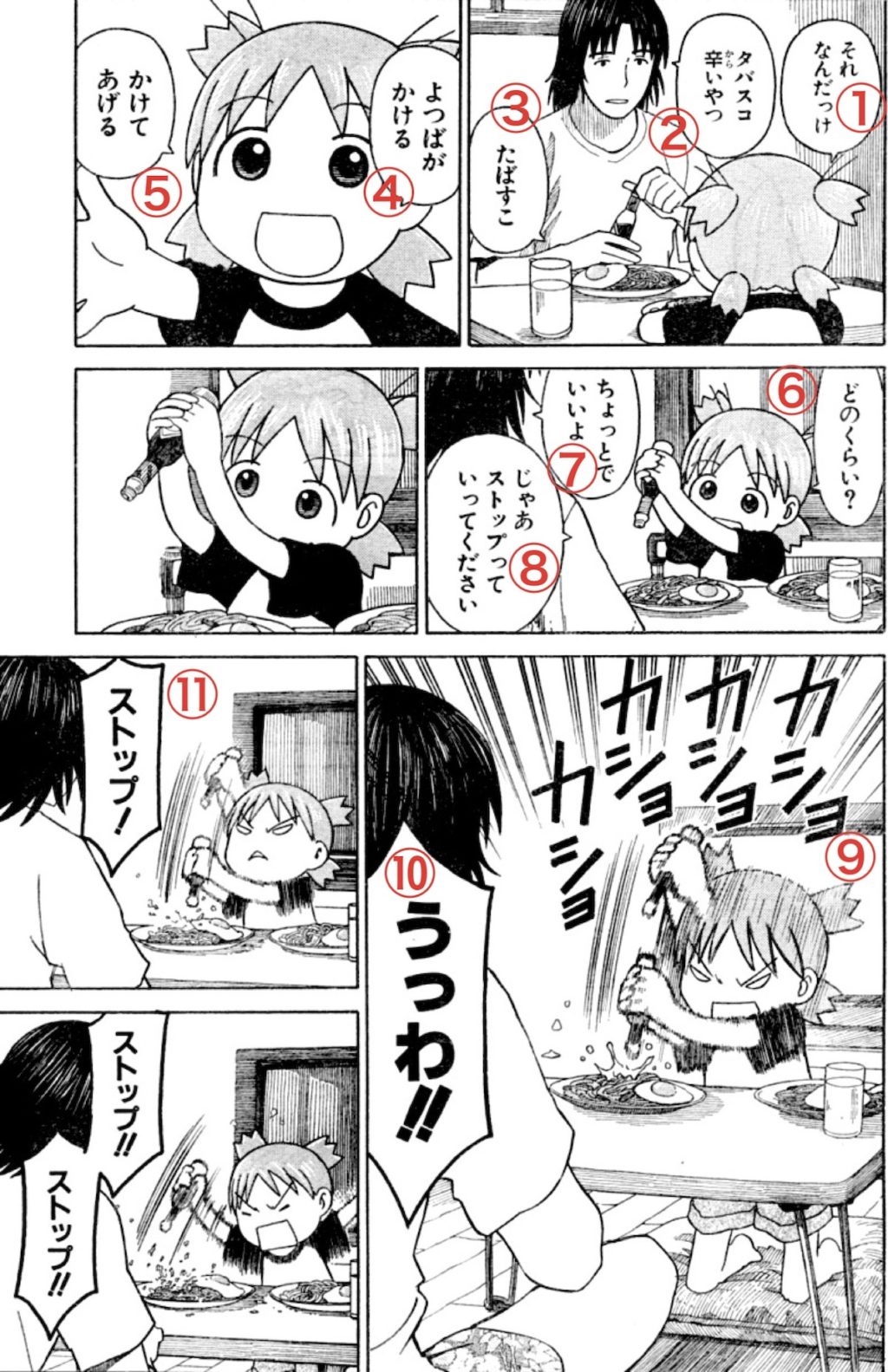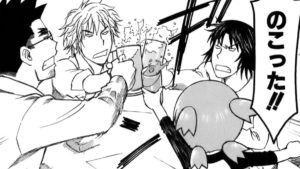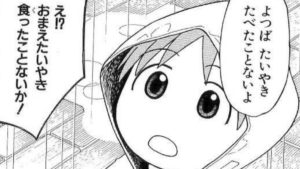Let’s learn Japanese with our analysis of manga. We will analyse a manga snippet from Yotsubato! (よつばと!) Volume 8.
CONTENTS
Manga Snippet
Sentences
Mouseover (tap on a smartphone/tablet) to reveal the censored romaji and English translation.
-
それなんだっけ?
sore nan dakke?
What’s that? -
タバスコ 辛いやつ
tabasuko karai yatsu
Tabasco, spicy stuff -
たばすこ
tabasuko
Tabasco -
よつばがかける
yotsuba ga kakeru
I’ll pour it -
かけてあげる
kakete ageru
I will pour it for you -
どのくらい?
dono kurai?
How much? -
ちょっとでいいよ
chotto de ii yo
Just a little bit is fine -
じゃあストップっていってください
jā sutopputte itte kudasai
Ok then, please say “stop” -
カショ カショ カショ カショ
kasho kasho kasho kasho
wham wham wham wham -
うっわ!!
uwwa!!
Woah! -
ストップ!
sutoppu!
Stop!
Analysis of Manga
-
「それなんだっけ?」
- それ (noun) – that
- なん (noun) – what
- だ (auxiliary) – makes a sentence declarative (attached to a noun or na-adjective)
- っけ (particle) – used when you are recalling something; “what is … again?” EXAMPLES
-
「タバスコ 辛いやつ」
- タバスコ (noun) – tabasco
- 辛い (i-adjective) – spicy
- やつ (noun) – stuff EXAMPLES
-
「たばすこ」
- たばすこ (noun) – tabasco
-
「よつばがかける」
- よつば (noun) – name of the main character meaning four (よつ) leaves (ば)
- が (particle) – indicates subject
- かける (verb) – pour
-
「かけてあげる」
- かけて (verb te-form) – pour
- あげる (auxiliary) – do something for you EXAMPLES
-
「どのくらい?」
- どの (adjective) – which
- くらい (particle) – approximate amount
-
「ちょっとでいいよ」
- ちょっと (noun) – a little
- でいい (grammar) – fine with … EXAMPLES
- よ (particle) – indicates certainty/emphasis
-
「じゃあストップっていってください」
- じゃあ (conjunction) – then
- ストップ (noun) – stop
- って (particle) – quotation marker EXAMPLES
- いって (verb te-form) – say
- ください (auxiliary) – please
-
「カショ カショ カショ カショ」
- カショカショ – onomatopoeia for shaking something with liquid in it
-
「うっわ!!」
- うっわ (interjection) – woah
-
「ストップ!」
- ストップ (noun) – stop
Examples
っけ (used when you are recalling something)
明日何時に待ち合わせだっけ?
ashita nanji ni machiawase dakke?
What time did you say we are meeting tomorrow?
家の鍵、閉めたっけ?
ie no kagi shimetakke?
Did I lock the front door?
It is used when talking to yourself or someone else.
やつ (stuff)
このガム、なんていうガム? – キシリトールガム。歯にいいやつ。
kono gamu, nante iu gamu? – kishiritōru gamu. ha ni ii yatsu.
What’s this chewing gum called? – Xylitol gum. The stuff that is good for your teeth.
このお菓子の中で一番甘いやつはどれ?
kono okashi no naka de ichiban amai yatsu wa dore?
Which one is the sweetest stuff within these snacks?
やつ is the casual version of 物 (thing).
Verb Te-Form + あげる (to do something for someone)
寝る前に本を読んであげる。
neru mae ni hon o yonde ageru.
I will read books for you before going to bed.
雨が降ってきたから、駅まで車で送ってあげる。
ame ga futte kita kara, eki made kuruma de okutte ageru.
It started raining so I will drive you to the station.
〜でいい (fine with …)
コーヒーでいい?
kōhī de ii?
Are you OK with coffee?
今夜は簡単な食事でいいよ。
kon’ya wa kantan na shokuji de ii yo.
I’m fine with a simple meal tonight.
って (quotation marker)
先生が「職員室まで来い」って言ってたよ。
sensei ga “shokuin-shitsu made koi” tte itteta yo.
The teacher said “come to the teacher’s room”.
もっと日本語の勉強頑張らなきゃって思う。
motto nihongo no benkyō ganbaranakyatte omou.
I think I have to study Japanese harder.
って is the casual version of と.
Support Easy Peasy Japanesey
If you enjoy our content, please consider supporting Easy Peasy Japanesey. Your support will help keep us going. Thanks for all your support!



